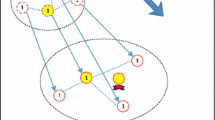Abstract
Under a harsh industrial environment, workforce safety, and satisfaction are key characteristics of a successful manufacturing operation. This paper proposes a job rotation approach that schedules workers based on NIOSH’s noise-exposure criteria and worker satisfaction related to overtime assignments. Multi-period noise-safe job rotation models are developed to determine optimal job rotation schedules for a heterogeneous workforce with different skill levels and preferences for preferred overtime periods. Demand requirements and the effect of job rotation on process continuity are considered. A numerical example is used to validate the usefulness and effectiveness of the proposed models. The scheduling models are solved under two main objectives: minimizing the total labor cost and maximizing the minimum level of worker satisfaction. Then, a multi-objective optimization technique is applied to find the most suitable compromise solution between the two objectives. The ability of the proposed models to promote worker-satisfaction equality is discussed.
Access this chapter
Tax calculation will be finalised at checkout
Purchases are for personal use only
Similar content being viewed by others
References
Occupational Safety and Health Administration (OSHA): Noise Exposure Computation. https://www.osha.gov/laws-regs/regulations/standardnumber/1910/1910.95AppA. Accessed 21 Sept 2018
Al-Dosky, B., Chowdhury, A., Mohammad, N., Haque, M., Manikandarajan, T., Eswar, A.: Noise level and annoyance of Industrial factories in Duhok city. IOSR J. Environ. Sci. Toxicol. Food Technol. 8(5), 1–8 (2014)
Ologe, F., Olajide, T., Nwawolo, C., Oyejola, B.: Deterioration of noise-induced hearing loss among bottling factory workers. J. Laryngol. Otol. 122(8), 786–794 (2008)
Feder, K., Michaud, D., McNamee, J., Fitzpatrick, E., Davies, H., Leroux, T.: Prevalence of hazardous occupational noise exposure, hearing loss, and hearing protection usage among a representative sample of working Canadians. J. Occup. Environ. Med. 59(1), 92 (2017)
Anjorin, S., Jemiluyi, A., Akintayo, T.: Evaluation of industrial noise: a case study of two Nigerian industries. Eur. J. Eng. Technol. 3(6), 59–68 (2015)
The National Institute of Occupational and Safety (NIOSH): Noise and Hearing Loss Prevention. https://www.cdc.gov/niosh/topics/noise/default.html. Accessed 21 Sept 2018
Rissén, D., Melin, B., Sandsjö, L., Dohns, I., Lundberg, U.: Psychophysiological stress reactions, trapezius muscle activity, and neck and shoulder pain among female cashiers before and after introduction of job rotation. Work Stress 16(2), 127–137 (2002)
Kaymaz, K.: The effects of job rotation practices on motivation: a research on managers in the automotive organizations. Bus. Econ. Res. J. 1(3), 69 (2010)
Tharmmaphornphilas, W., Green, B., Carnahan, B.J., Norman, B.A.: Applying mathematical modeling to create job rotation schedules for minimizing occupational noise exposure. AIHA J. 64(3), 401–405 (2003)
Yaoyuenyong, S., Nanthavanij, S.: Hybrid procedure to determine optimal workforce without noise hazard exposure. Comput. Ind. Eng. 51(4), 743–764 (2006)
Wongwien, T., Nanthavanij, S.: Ergonomic workforce scheduling under complex worker limitation and task requirements: mathematical model and approximation procedure. Songklanakarin J. Sci. Technol. 34(5), 541–549 (2012)
Aryanezhad, M., Kheirkhah, A., Deljoo, V., Mirzapour Al-e-hashem, S.: Designing safe job rotation schedules based upon workers’ skills. Int. J. Adv. Manuf. Technol. 41(1–2), 193–199 (2009)
Deljoo, V., Mirzapour Al-e-hashem, S., Malekly, H., Bozorgi-Amiri, A., Aryanejad, M.: Applying multi objective modeling to create safe job rotation schedules based upon workers’ skills and idleness. In: Computers & Industrial Engineering 2009, pp. 262–267. IEEE (2009)
Nanthavanij, S., Yaoyuenyong, S., Jeenanunta, C.: Heuristic approach to workforce scheduling with combined safety and productivity objective. Int. J. Ind. Eng. 17(4), 319–333 (2010)
Moussavi, S., Mahdjoub, M., Grunder, O.: Reducing production cycle time by ergonomic workforce scheduling. IFAC-PapersOnLine 49(12), 419–424 (2016)
Mossa, G., Boenzi, F., Digiesi, S., Mummolo, G., Romano, V.: Productivity and ergonomic risk in human based production systems: a job-rotation scheduling model. Int. J. Prod. Econ. 171, 471–477 (2016)
Asawarungsaengkul, K., Nanthavanij, S.: Heuristic genetic algorithm for workforce scheduling with minimum total worker-location change over. Int. J. Ind. Eng. Theory Appl. Pract. 15(4), 373–385 (2008)
Rerkjirattikarn, P., Satitanekchai, S., Olapiriyakul, S.: Safe job rotation scheduling with minimum setup time. Asia Pac. J. Sci. Technol. 22(4), 9 (2017). APST-22-04-03
Rerkjirattikarn, P., Satitanekchai, S., Olapiriyakul, S.: Designing safe job rotation schedules with minimum productivity loss. J. Supply Chain. Oper. Manag. 14(2), 48–60 (2016)
Niakan, F., Baboli, A., Moyaux, T., Botta-Genoulaz, V.: A bi-objective model in sustainable dynamic cell formation problem with skill-based worker assignment. J. Manuf. Syst. 38, 46–62 (2016)
Rerkjirattikal, P., Kaorapapaong C., Olapiriyakul S.: Skill-based job rotation scheduling for occupational noise exposure control. In: International Conference on Artificial Life and Robotics 2018, pp. 161–165 (2018)
Adoly, A., Gheith, M., Nashat Fors, M.: A new formulation and solution for the nurse scheduling problem: a case study in Egypt. Alex. Eng. J. 57, 2289–2298 (2018)
Rocha, M., Oliveira, J., Carravilla, M.: A constructive heuristic for staff scheduling in the glass industry. Ann. Oper. Res. 214, 463–478 (2014)
Wongwien, T., Nanthavanij, S.: Priority-based ergonomic workforce scheduling for industrial workers performing hazardous jobs. J. Ind. Prod. Eng. 34(1), 52–60 (2017)
Beckers, D.G., van der Linden, D., Smulders, P.G., Kompier, M.A., Taris, T.W., Geurts, S.A.: Voluntary or involuntary? Control over overtime and rewards for overtime in relation to fatigue and work satisfaction. Work Stress 22(1), 33–50 (2008)
Yang, G., Tang, W., Zhao, R.: An uncertain workforce planning problem with job satisfaction. Int. J. Mach. Learn. Cybernet. 8(5), 1681–1693 (2017)
Agrali, S., Taskin, Z.C., Unal, A.T.: Employee scheduling in service industries with flexible employee availability and demand. Omega 66, 159–169 (2017)
Hollman, R.W.: Overtime working: employee willingness. Employee Relations 2(5), 26–29 (1980)
Acknowledgement
The authors gratefully acknowledge the financial support provided by Thammasat University Research Fund under the TU Research Scholar, Contract No. 2/21/2560.
Author information
Authors and Affiliations
Corresponding author
Editor information
Editors and Affiliations
Rights and permissions
Copyright information
© 2019 Springer Nature Switzerland AG
About this paper
Cite this paper
Rerkjirattikal, P., Olapiriyakul, S. (2019). Overtime Assignment and Job Satisfaction in Noise-Safe Job Rotation Scheduling. In: Seki, H., Nguyen, C., Huynh, VN., Inuiguchi, M. (eds) Integrated Uncertainty in Knowledge Modelling and Decision Making. IUKM 2019. Lecture Notes in Computer Science(), vol 11471. Springer, Cham. https://doi.org/10.1007/978-3-030-14815-7_3
Download citation
DOI: https://doi.org/10.1007/978-3-030-14815-7_3
Published:
Publisher Name: Springer, Cham
Print ISBN: 978-3-030-14814-0
Online ISBN: 978-3-030-14815-7
eBook Packages: Computer ScienceComputer Science (R0)




